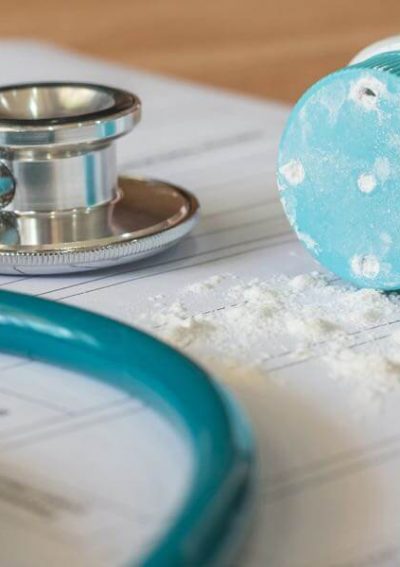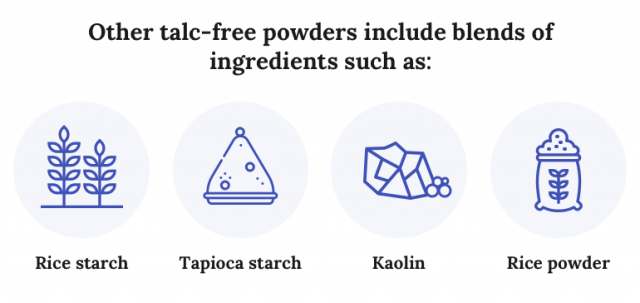Talcum Powder and Cancer
For over a century, Johnson’s Baby Powder and other talcum powder products have been marketed as essential for baby care and feminine hygiene. But a growing body of research has found connections between baby powder use and cancer.

For decades, baby powder has been marketed as a safe and essential personal care product. But a growing body of research suggests that inhaling talcum powder or using it near a woman’s genitals may raise a person’s risk of developing cancer.
Doctors and scientists have been raising concerns about potential links between talc and cancer for more than 50 years.
In the late 1960s, researchers noted higher rates of mesothelioma among talc miners in New York. The rare cancer affects the lining of the lungs and other organs.
It was around the same time that concerns about a possible link between talcum powder and ovarian cancer first surfaced. Since 1982, at least 21 epidemiological studies have suggested that sprinkling talc near a woman’s genitals — a habit known as “perineal dusting” — may increase her risks of developing the deadly disease. During the same period, nine studies have shown no apparent link.
In August 2022, Johnson & Johnson announced it would stop selling its talc-based baby powder globally in 2023 because of low sales. The company said the decision is not related to any talcum powder safety issues or links to cancer.
Links to Ovarian Cancer
There are different theories on how using talcum powder may raise the risk of ovarian cancer. Some scientists believe talcum powder migrates up a woman’s vaginal canal and causes inflammation of the cells, which eventually develops into cancer.
Others believe women are unwittingly dusting themselves with talcum powder that’s contaminated with asbestos, a mineral known to cause cancer. The asbestos, they theorize, travels up inside a woman and damages cells in a way that causes them to turn cancerous.
Interestingly, animal studies from the 1960s lend support to the asbestos theory. In a 1967 study published in the journal of Environmental Research, researchers injected asbestos into guinea pigs’ abdomens. They reported changes in the animals’ ovaries “similar to those seen in patients with early ovarian cancer.”
The researchers even noted that mesothelioma caused by asbestos resembles ovarian cancer on the cellular level.
Talc products that may pose an ovarian cancer risk include:
- Baby powder
- Bath bombs
- Body wipes
- Body powder
- Diaper and rash creams
- Genital deodorants and antiperspirants
The asbestos explanation has gained more traction both in courtrooms and in the media recently.
In July 2018, a St. Louis jury awarded a $4.69 billion verdict to 22 women who developed ovarian cancer after decades of using Johnson’s Baby Powder and other talc products for feminine hygiene purposes.

During the trial, lawyers interviewed expert witnesses who found microscopic traces of asbestos and talc in the ovarian and endometrial tissue removed from some of the women. The experts tested old samples of Johnson’s Baby Powder and found they contained the same types of asbestos.
In December 2018, Reuters reported that Johnson & Johnson, the world’s leading baby powder manufacturer, knew its talcum powder sometimes contained asbestos over the years but kept the public in the dark. The report was based on internal company documents that came to light in talcum powder lawsuits. A New York Times report raised many of the same concerns.
Johnson & Johnson has called such news reports sensationalistic, and the company stands by its baby powder.
“The decades-long record overwhelmingly shows that our talc is safe, and J&J has engaged with great transparency in open discussions on the safety of its talc with scientists and regulators, and we will continue to defend our position,” Johnson & Johnson said on its website.
The U.S. Food and Drug Administration, meanwhile, is conducting its own research on possible links between talc and ovarian cancer. The focus of that research relates to how talc may move from a woman’s vaginal area to her ovaries and possible mechanisms by which it might turn normal cells into cancer cells.
Mesothelioma Connection
Talcum powder has also been linked to a rare and deadly cancer called mesothelioma. While mesothelioma can affect the linings of lungs, abdomen and heart, approximately three-quarters of mesothelioma cases involve the lungs.
Exposure to asbestos is the leading cause of mesothelioma.
Scientific studies suggest people can develop mesothelioma by inhaling or ingesting talcum powder that’s contaminated with asbestos. Using talcum powder in closed spaces may increase these inhalation risks, according to a 2014 study published in the International Journal of Occupational and Environmental Health.
The study, which was performed in conjunction with litigation, looked at one brand of talcum powder used by 10 women who developed mesothelioma.
The study showed that the brand they had used contained asbestos. The scientists traced the asbestos in the talc back to the mines where the talc originated. They also found traces of the asbestos in the lymph node and lung tissue of at least one of the women who developed mesothelioma.
Other Cancers
While less is known about talcum powder’s connection to other types of cancers, some studies have demonstrated possible risks.
A 2011 study in the journal Cancer Epidemiology, Biomarkers & Prevention, for instance, found a small increased risk of endometrial cancer among post-menopausal women who used talcum powder on their genitals.
Using data from the Nurses’ Health Study (NHS), the researchers analyzed the medical history of 66,028 women, including 599 who had invasive endometrial cancer. It showed that post-menopausal women who had used talc on their genitals had a 21 percent increased risk of endometrial cancer. Those who had used talcum powder more than once a week had a 24 percent increased risk of endometrial cancer.

Animal studies, meanwhile, have demonstrated possible links between talcum powder inhalation and other malignancies, including lung cancer and cancer of the adrenal gland. The rate of lung cancer is also higher among those who work in the talc industry, according to federal studies.
A 1995 study conducted by the National Institute for Occupational Safety and Health (NIOSH) found that talc workers had double the rate of lung cancer than the general public. While some of those individuals may have had other risk factors, the agency concluded that exposure to talc in mining and milling operations played a part.
“Although smoking or work exposures at other jobs may have contributed to these deaths, we do not think they explain the entire excess,” the agency stated. “We believe talc was also responsible.”
Minimizing Risks
If you’re worried about possible cancer risks associated with talcum powder, your best bet is to avoid using it. You may want to try a cornstarch-based powder instead. Other talc-free powders include blends of ingredients such as rice starch, tapioca starch, kaolin and rice powder.

If you do use talcum powder, you should avoid inhaling it, and if you’re a woman, you should avoid using it in your genital region. If you chose to use talcum powder, use the least amount possible.
While talc is a common ingredient in numerous consumer products, there is no indication that talcum powder contained in foods, pharmaceuticals or cosmetics, such as eye shadows or blushes, poses any cancer risks.
If you’re concerned that you may have a health issue related to talc exposure, talk to your doctor.
26 Cited Research Articles
Consumernotice.org adheres to the highest ethical standards for content production and references only credible sources of information, including government reports, interviews with experts, highly regarded nonprofit organizations, peer-reviewed journals, court records and academic organizations. You can learn more about our dedication to relevance, accuracy and transparency by reading our editorial policy.
- Johnson & Johnson. (2022, August 11). Johnson & Johnson Consumer Health to Transition Global Baby Powder Portfolio to Cornstarch. Retrieved from https://www.jnj.com/johnson-johnson-consumer-health-to-transition-global-baby-powder-portfolio-to-cornstarch
- American Cancer Society. (2018, December 3). Talcum Powder and Cancer. Retrieved from https://www.cancer.org/cancer/cancer-causes/talcum-powder-and-cancer.html
- American Cancer Society. (2019, January 8). Key Statistics for Ovarian Cancer. Retrieved from https://www.cancer.org/cancer/ovarian-cancer/about/key-statistics.html
- Bostock, B. (2018, December 6). Canada warns talcum powder poses a risk of ovarian cancer after $4.69 billion product defect case. Retrieved from https://www.businessinsider.com/canadia-talcum-powder-poses-risk-of-ovarian-cancer-fibrosis-2018-12
- Cramer, D.W. et al. (2016, May). The Association Between Talc Use and Ovarian Cancer: A Retrospective Case-Control Study in Two U.S. States. Retrieved from https://journals.lww.com/epidem/Fulltext/2016/05000/The_Association_Between_Talc_Use_and_Ovarian.6.aspx
- Dyer, Owen. (2018, December 28). Johnson & Johnson knew for decades talcum powder contained asbestos, reports allege. Retrieved from https://www.bmj.com/content/363/bmj.k5430
- Girion, L. (2018, December 14). Powder Keg: Johnson & Johnson knew for decades that asbestos lurked in its Baby Powder. Retrieved from https://www.reuters.com/investigates/special-report/johnsonandjohnson-cancer/
- Gordon, R.E., Fitzgerald, S. & Millette, J. (2014, October). Asbestos in commercial cosmetic talcum powder as a cause of mesothelioma in women. Retrieved from https://www.ncbi.nlm.nih.gov/pubmed/25185462
- Government of Canada. (2018, December 13). Talc: Learn about talc and if it’s safe. Retrieved from https://www.canada.ca/en/health-canada/services/chemicals-product-safety/talc.html
- Graham, J. & Graham, R. (1967, October). Ovarian cancer and asbestos. Retrieved from https://www.sciencedirect.com/science/article/pii/0013935167900084
- Hull, M.J., Abraham, J.L. & Case, B.W. (2002, December 1). Mesothelioma among Workers in Asbestiform Fiber-Bearing Talc Mines in New York State. Retrieved from https://academic.oup.com/annweh/article/46/suppl_1/132/317491
- Jabion, R. (2017, October 20). Judge tosses $417M award in claim baby powder caused cancer. Retrieved from https://www.usatoday.com/story/money/business/2017/10/20/judge-tosses-417-m-award-claim-baby-powder-caused-cancer/786625001/
- Johnson & Johnson. (2018, December 15). Johnson & Johnson Statement on December 15 the New York Times Article. Retrieved from https://www.jnj.com/our-company/johnson-johnson-issues-statement-on-december-15-following-the-new-york-times-article
- Karageorgi, S. et al. (2011, May 1). Perineal use of talcum powder and endometrial cancer risk. Retrieved from https://www.ncbi.nlm.nih.gov/pmc/articles/PMC2866017/
- Kleinfeld, M. et al. (1967, January 10). Mortality Among Talc Miners and Millers in New York State. Retrieved from https://www.tandfonline.com/doi/abs/10.1080/00039896.1967.10664815
- Langseth, H. et al. (2008, March 13). Perineal use of talc and risk of ovarian cancer. Retrieved from https://jech.bmj.com/content/62/4/358.info
- McGinley, L. (2017, August 28). Does talcum powder cause ovarian cancer? Retrieved from https://www.chicagotribune.com/lifestyles/health/ct-baby-talcum-powder-ovarian-cancer-20170828-story.html
- Muscat, J.E. & Huncharek, M.S. (2008, April). Perineal Talc Use and Ovarian Cancer: A Critical Review. Retrieved from https://www.ncbi.nlm.nih.gov/pmc/articles/PMC3621109/
- Muscat, J.E. & Huncharek, M.S. (2998, April). Perineal Talc Use and Ovarian Cancer: A Critical Review. Retrieved from https://www.ncbi.nlm.nih.gov/pmc/articles/PMC3621109/
- National Toxicology Program. (1993, September). TOXICOLOGY AND CARCINOGENESIS STUDIES OF TALC (CAS NO. 14807-96-6) IN F344/N RATS AND B6C3F, MICE (INHALATION STUDIES). Retrieved from https://ntp.niehs.nih.gov/ntp/htdocs/lt_rpts/tr421.pdf
- Steenhuysen, J. (n.d.). Evidence on Talc Cancer Risk Differs for Jurors, Researchers. Retrieved from https://www.scientificamerican.com/article/evidence-on-talc-cancer-risk-differs-for-jurors-researchers/
- The Associated Press. (2017, May 5). Woman awarded record $110M in baby powder lawsuit. Retrieved from https://www.thestar.com/business/2017/05/05/woman-awarded-record-110m-in-baby-powder-lawsuit.html
- The Centers for Disease Control and Prevention. (1995). Worker Health Study Summaries: Research on long-term exposure Talc Miners and Millers (Talc). Retrieved from https://www.cdc.gov/niosh/pgms/worknotify/talc.html
- Ubelacker, S. (2018, December 5). Talcum powder could pose danger to lungs and ovaries, Health Canada warns. Retrieved from https://www.cbc.ca/news/health/talcum-powder-may-be-harmful-to-lungs-health-canada-1.4933506
- Yale Medicine. (n.d.). Mesothelioma: Symptoms, Diagnosis & Treatment. Retrieved from https://www.yalemedicine.org/conditions/mesothelioma
- Zuckerman, D. & Shapiro, D. (n.d.). Talcum Powder and Ovarian Cancer. Retrieved from http://www.center4research.org/talcum-powder-ovarian-cancer/
Calling this number connects you with a Consumer Notice, LLC representative. We will direct you to one of our trusted legal partners for a free case review.
Consumer Notice, LLC's trusted legal partners support the organization's mission to keep people safe from dangerous drugs and medical devices. For more information, visit our partners page.
855-613-6647



